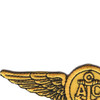Description
They are the eyes, ears, and lifeline of naval aviation—the men and women who bring a U.S. Navy aircraft’s full power to life. Naval Aircrew serve in the skies above every ocean, operating mission systems, managing communications, manning rescue gear, spotting threats, and keeping aircraft alive in the harshest conditions. Their work is equal parts precision, nerve, and endurance, forged in cockpits and cabins where every decision can shape the outcome of a mission.
The legacy of Naval Aircrew stretches back to the earliest days of flight at sea. In World War II, aircrewmen rode aboard PBY Catalinas searching the endless Pacific for downed aviators and enemy ships. They manned gun positions on SBD Dauntlesses and TBF Avengers, braving fierce anti-aircraft fire as carriers launched wave after wave in battles like Coral Sea, Midway, and the Philippine Sea. Their vigilance and skill helped turn the tide of the war.
During the Cold War, Naval Aircrew expanded into a broad and highly technical profession. P-3 Orion crews hunted Soviet submarines across the vast Atlantic and Arctic, flying missions that lasted more than 10 hours at a time. Helicopter crews from HSC, HSM, and legacy HS and HC squadrons conducted anti-submarine operations, lifted sailors from pitching ships, and flew rescues in storms where the ocean heaved like a living thing. Aircrew aboard E-2 Hawkeyes, C-2 Greyhounds, and transport aircraft kept carrier groups informed, supplied, and operational across the globe.
In Vietnam, they flew low across rice paddies and coastal waters, supporting riverine units, spotting for ground forces, and executing daring medevacs under fire. More recently, Naval Aircrew have flown combat missions in Iraq and Afghanistan, patrolled the South China Sea, rescued survivors after hurricanes, and monitored global hotspots from the air. They respond to distress calls, track surface threats, carry supplies to remote ships, and provide overwatch for Marines and sailors in harm’s way.
Their work requires mastery beyond the aircraft itself—navigation, weapon systems, acoustic tracking, hoisting operations, electronic warfare, sensor operation, survival at sea, and teamwork that must be perfect every single time. In cramped cabins, roaring rotors, and freezing altitudes, these aircrew professionals keep the mission on track and bring their aircraft home again.
The Naval Aircrew patch honors this proud and demanding lineage. It represents the professionalism of crews who fly into storms, darkness, and combat zones; the vigilance of those who watch the seas from above; and the legacy of a community that has shaped naval operations for more than a century. To wear it is to acknowledge the skill, courage, and teamwork that define every aircrew flight.
1 Review
-
Navy Aircrew Wings
All of the patches I have purchased have been absolutly the very Best!

















